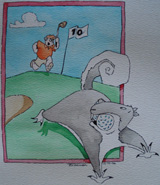 Golf Ball Bandits: Page 9
Golf Ball Bandits: Page 9Some quick squirrel facts:
Squirrels' eyes swivel around constantly on the lookout for danger. A trait that makes it risky to feed them by hand, as they're likely to bite unsuspecting fingers. Their incisors grow six inches a year to compensate for all the hard chewing that they do, sometimes stripping almost two-hundred pine cones in a single day.
Squirrels can eat mushrooms that would be toxic to humans, as their digestive tract is able to neutralise the poison. Before burying food for winter, they lick or rub it against their fur for the scent. Their highly developed sense of smell enabling them to detect a pine cone buried a foot beneath the snow.
Squirrels live in "dreys," which are nests built of sticks and leaves, and lined with feathers. They live alone, except for mothers and their young. Or, if it's very cold, they might double up for warmth. They have well-curved claws designed for purchase, in their rapid descent down trees, and can be very vocal, with a raucous selection of rattles, screeches and growls as part of their repertoire. They can run at speeds of up to 25 kilometers an hour.
Squirrels communicate with each other using a series of chirps, and by flicking their tails.
And there is nothing more important to a squirrel than its tail. Because not only does it serve as a status symbol Ð the fluffier the tail the bigger the squirrel will appear, but is also relied upon for so much of its daily activities. While jumping through the trees it's a rudder for steering, and for safe landings a parachute. It's a blanket in winter, an umbrella when it's raining, and a parasol in the sun. And they can even be employed to escape a predator by shedding its sheath and some of its bones.
Author's Note: This story is based on the recent activity at an Edmonton golf course, where the squirrels are making off with the balls.